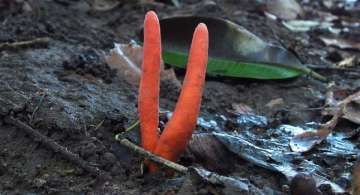One of the world's deadliest species of fungi, the Poison Fire Coral, has been identified growing in Australia for the first time, with a specimen appearing in Queensland state.
Experts from Australia's James Cook University revealed the finding earlier in the week, warning the public not eat or even touch the bright red fungus which normally grows in the mountains of Japan and the Korean Peninsula, Xinhua news agency reported on Thursday.
"Of the hundred or so toxic mushrooms that are known to researchers, this is the only one in which the toxins can be absorbed through the skin," said mycologist Matt Barrett at James Cook University's Australian Tropical Herbarium (ATH).
Poison Fire Coral is listed as the world's second-deadliest fungus and has been responsible for several fatalities in Japan and Korea, where it is sometimes mistaken as medicine and brewed into a tea.
"Just touching the Fire Coral fungus can cause dermatitis (reddening or swelling of the skin)," Barrett said.
"If eaten, it causes a horrifying array of symptoms: initially stomach pain, vomiting, diarrhoea, fever and numbness, followed over hours or days by delamination of skin on face, hands and feet and shrinking of the brain, which, in turn, causes altered perception, motion difficulties and speech impediments."
Experts believe that the fungi's appearance in Australia is most likely natural as there have also been unconfirmed reports of it growing in the nearby islands of Papua New Guinea and Indonesia.
Barrett said that there are still many species of fungi yet to be identified in Australia, noting that since he joined the ATH in 2018, he has helped to identify over 20 species of fungi not previously known to live in the area.
"The fact that we can find such a distinctive and medically important fungus-like Poison Coral Fire Coral right in our backyard shows we have much to learn about fungi in northern Australia," he added.
Also Read | No, ISRO has not given up efforts to contact Vikram Lander
Also Read | NASA invites names to ride along with Mars 2020 rover, last date today
